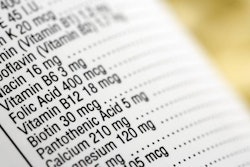
No one reads the back of pet food labels, according to Jim Barritt, government and regulatory affairs manager for Mars Petcare US, because they are so confusing and overwhelming. His assessment derived from discussion sessions held by his company with pet food-buying consumers in 2013; he presented the findings during the 2015 Feed and Pet Food Joint Conference last fall to update participants on a Pet Food Institute (PFI) task force formed to try and have some influence on potential new pet food labeling rules that might arise as part of the Food and Drug Administration (FDA) Amendment Act, passed in 2007 after the melamine-related pet food recalls.
Even pet owners who do read the back of pet food packaging look only at the first two to three ingredients, the percentage of protein (and possibly fat) and serving sizes (if the shopper is considering a new brand), Barritt said. The guaranteed analysis is a particular source of bewilderment for pet food shoppers, some of whom recommended having a Nutrition Facts box similar to what appears on human food products—even though many of the consumers don’t understand that information either, at least they’re familiar with it. (The task force has in fact recommended to FDA that a Nutrition Facts box be added to pet food labels, along with other changes.)
Interpreting pet food labels
Barritt’s information and comments came to mind after someone shared with me an article, How to Interpret Pet Food Labels, published in the August/September issue of Mother Earth News. To me, the article symbolizes both the problems and the promise of pet food labels.
First, I want to commend Mother Earth News and the writer, Hannah Kincaid, for tackling the subject. For a publication that bills itself as the “longest-running sustainable-lifestyle magazine,” the topic of pet food labels seems a little far afield, though the website also proclaims the medium as the “original guide to living wisely.” And no doubt many of Mother Earth News’ readers have pets that they want to choose wisely and, possibly, sustainably for. (Kincaid herself has two dogs.)
While Kincaid’s overview is pretty basic, that seems to meet the comprehension level of most pet owners when it comes to pet food labels, as indicated by the Mars research. And, in a somewhat pleasant surprise, the information she presents is generally accurate and on point. She seems to have fallen for some of the popular concepts and prevalent myths about pet food and pet nutrition—a hyper focus on protein, the notion that all by-products are bad, the calling out of specific “red flag” ingredients—but otherwise does a good job of explaining how pet food labels are regulated, which terms are defined and which are truly just marketing.
Human food and pet food labels don't match up
Some of the information is just too basic and not helpful, I’m afraid. About the guaranteed analysis, Kincaid writes: “Much like human food, the guaranteed analysis on any package or can of pet food will tell you the overall fat, protein, fiber and moisture content of the food. Look for a healthy balance of nutrients and moisture.” (This is part of a tip box that apparently appears in the printed article but not online.)
Hmmm. Well, as the Mars consumer sessions indicated, labels for human food rarely have a guaranteed analysis anymore; they have Nutrition Facts boxes (which might have the guaranteed analysis buried within them). So that analogy just won’t hold for most consumers. And, what exactly is a “healthy balance” of nutrients and moisture for a dog or cat? Most pet owners don’t know; many of us don’t even know what that balance is for ourselves.
Understanding proper pet nutrition
Also, despite her focus on protein ingredients, Kincaid is not forceful enough in explaining just how dangerous a vegetarian diet is for a cat. She does quote the Humane Society of the United States (another surprise): “It’s unfair and unrealistic to impose human ethical standards on cats. And forcing a cat to eat a diet that isn’t based on meat imperils its health and its life.” But she doesn’t fully clarify why cats are true carnivores or completely shut down vegetarianism as an option for cats: “If you insist on feeding your cat a vegetarian diet, consider personally adding vitamin and mineral supplements to its food.” (In what amounts and from what sources? That’s a pretty scary recommendation.)
In terms of pet food labels, the real problem behind these and other points of misinformation in Kincaid’s article is the fundamental lack of understanding about pet nutrition among the millions of people around the world who consider their pets part of the family. There is a strong analogy between that and human nutrition/human food labels, but at least with our own nutrition, we can communicate with medical professionals, and we can experience directly how we feel in terms of what we eat. The experience for our pets is much fuzzier to us.
Yet, there is so much promise for clearer, simpler labeling for human and pet foods alike. Based on consumer suggestions, PFI’s task force has recommended some sound changes. In addition, the Association of American Feed Control Officials (AAFCO) is convening its own working group to explore the possibility of “modernizing” pet food labeling. Unfortunately, that description doesn’t inspire confidence that we’ll see progress any time soon, particularly given AAFCO’s typical snail’s pace. But at least it’s on the radar screen and could also help inform and influence potential new regulations from the equally sloth-like FDA.

















